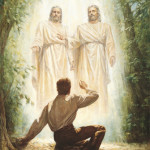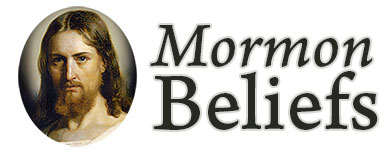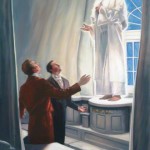The Church of Jesus Christ of Latter-day Saints has a rich history that dates back to the early 1800s. Although the Church was officially organized on April 6, 1830, preparations for that day began years earlier. From the First Vision of Joseph Smith to the coming forth of the Book of Mormon and the organization of The Church of Jesus Christ to the modern days, Mormons believe they have a rich spiritual heritage. And they have kept records of many of these experiences. Joseph Smith, the founding prophet of The Church of Jesus Christ, was commanded: “Behold, there shall be a record kept among you” (Doctrine & Covenants 21:1).
But being a record-keeping people is more than a commandment. Mormons believe that it also defines who they are. Elder Marlin K. Jensen, at the time a Church Historian and Recorder, said,
A people can be no greater than its stories.
Joseph Smith appointed Oliver Cowdery as the first Church Historian. In addition, many Church members have also kept journals and other personal records of their experiences. Church Historian Elder Steven R. Snow said:
“I enjoy reading historical accounts of the early Church members who left their homes and, with great sacrifice, gathered with the Saints. I find their stories compelling, and I draw great strength from learning what they went through to live and demonstrate their faith by following the prophets and doing hard things. When you read what they did, somehow your lot in life doesn’t seem quite so difficult.”
Elder Jensen said:
“We keep records to help us remember, and a record of the Church’s rise and progress has been kept from Oliver Cowdery’s time to the present day. This extraordinary historical record reminds us that God has again opened the heavens and revealed truths that call our generation to action.”
This call to action includes studying history to learn from it—the good and the bad. President Dieter F. Uchtdorf taught:
“… History is important. And keeping ourselves anchored to the lessons learned from history will enable us to emulate the best of what it means to be human. It can also help us avoid the worst.”
History is more than just a compilation of facts and events, it is also the story of those who lived through them. Mormon history is no exception. It is the story of the Mormon people—their faith, their trials and triumphs and their religion.
Timeline of Events:
Spring 1820: Joseph Smith Receives The First Vision.
 At the age of 14, young Joseph and his family were caught up in the religious revival of the time. Confused about which church he should join, and not wanting to join the wrong one, he knelt down in a grove of trees in the spring of 1820 and asked God. In answer to his humble petition, young Joseph was visited by God the Father and His Son, Jesus Christ, who told him not to unite himself with any of the churches. Through him, They said, the true gospel of Jesus Christ would be restored to the earth. Mormons call this the First Vision, and they believe that it marked the beginning of the Restoration of the gospel of Jesus Christ.
At the age of 14, young Joseph and his family were caught up in the religious revival of the time. Confused about which church he should join, and not wanting to join the wrong one, he knelt down in a grove of trees in the spring of 1820 and asked God. In answer to his humble petition, young Joseph was visited by God the Father and His Son, Jesus Christ, who told him not to unite himself with any of the churches. Through him, They said, the true gospel of Jesus Christ would be restored to the earth. Mormons call this the First Vision, and they believe that it marked the beginning of the Restoration of the gospel of Jesus Christ.
September 1823: The Angel Moroni Visits Joseph Smith.
An angel named Moroni was sent by God to instruct Joseph about restoring the gospel of Jesus Christ. Moroni directed Joseph to a nearby hill, later called Cumorah, where centuries earlier had been hidden translate gold plates, upon which was written a record of peoples who lived in the ancient Americas that contained the fullness of the gospel of Jesus Christ. Moroni told Joseph that he was to translate the writings and publish them. After four years, Joseph was allowed to take the plates. He finished the translation in June 1829, after which the same angel Moroni came and retrieved the gold plates.
May 15, 1829: The Aaronic Priesthood Is Restored.
The priesthood could only be restored to the earth by one who held it anciently. Thus, John the Baptist conferred the Aaronic Priesthood on Joseph Smith and Oliver Cowdery in Harmony, Pennsylvania.
June 1829-April 1830: The Melchizedek Priesthood Is Restored.
Joseph Smith and Oliver Cowdery received the Melchizedek Priesthood from Peter, James, and John near the Susquehanna River between Harmony, Pennsylvania, and Colesville, New York.
March 1830: The Book Of Mormon: Another Testament of Jesus Christ Is Published.
The first copies of The Book of Mormon were made available to the public on March 26, 1830, at the E.B. Grandin Bookstore in Palmyra, New York.
April 6, 1830: The Church of Jesus Christ of Latter-day Saints Is Officially Organized.
The Church of Jesus Christ of Latter-day Saints was officially organized at the log home of Peter Whitmer, Sr., in Fayette, New York. The Prophet Joseph Smith said that the Lord had revealed to him the date that this should occur. Although 56 men and women were gathered at the home, the Prophet Joseph chose 6 men to assist in the organization of the Church.
September-October 1830: The First Mormon Missionaries Are Called.
The Church of Jesus Christ was in its infancy when the first missionaries were called to preach the gospel. Oliver Cowdery, who had helped Joseph Smith translate the plates, was to lead the small group of men on their mission to the American Indians, among whom Mormons believe are the remnants of the Book of Mormon peoples known as Lamanites. As they journeyed through Ohio, they also taught the gospel to a minister and others in the northeastern part of the state. Within three weeks of the missionaries’ arrival, 127 persons had been baptized in the Kirtland, Ohio, area—which doubled the membership of the Church.
December 1830-January 1831: The Latter-day Saints Were Called to Gather in Kirtland, Ohio.
In January 1831, Joseph Smith revealed to the various branches of the Church in New York that the Lord had commanded them to gather in Ohio. In Kirtland, Ohio, the basic organization of The Church of Jesus Christ was revealed to the Prophet Joseph. It was also here that the Latter-day Saints built their first temple. Saints were also gathering in Jackson County, Missouri. Eventually, however, due to an apostasy in Kirtland, many of the faithful Latter-day Saints left Ohio for Missouri in July 1838.
March 27, 1836: The Kirtland, Ohio, Temple Was Dedicated.
In December 1832, the Lord had commanded the Latter-day Saints to build a temple in Kirtland. (See Doctrine & Covenants 88:119.) Construction of the temple began on June 6, 1833, and the cornerstone was laid on July 23. Mobs threatened to destroy the temple, so those who worked on its construction by day guarded it with rifles by night. The Latter-day Saints sacrificed much in their time, effort and resources—including gathering china that was crushed and added to the plaster so that the outside glittered—in building the Lord’s house. Because of their willingness to sacrifice, they were blessed with a Pentecostal season, where many Latter-day Saints beheld visions and other unusual spiritual manifestations—more than in any other era in the Church. This lasted from January 21 to May 1, 1836.
July 6, 1838: Latter-day Saints Leave Kirtland, Ohio.
The Latter-day Saints had enjoyed many spiritual experiences in Kirtland, Ohio, following the dedication of the temple. However, in the time since the Church had been beset by apostasy. The Prophet Joseph and other Church leaders had to flee from assassination attempts by those who had been their friends and associates. In July, many of the faithful Ohio Latter-day Saints left their homes and belongings and started a trek to Missouri.
October 1838: Missouri Governor Lilburn Boggs Issued The “Extermination Order.”
For many years, angry mobs had been persecuting the Latter-day Saints. They had been violently forced out of their homes and driven from place to place. They had lost property and been violated but were denied redress from the government. Eventually, Missouri Gov. Lilburn Boggs issued what is known as the “Extermination Order,” which said that Mormons who didn’t leave the state could be killed.
October 1839: Commerce, Illinois, Was Renamed Nauvoo.
Having been driven out of Missouri, the Latter-day Saints settled in Commerce, Illinois. They built up the city and renamed it Nauvoo, meaning “beautiful city.” Here, they enjoyed peace for a time. However, it did not last.
June 27, 1844: The Prophet Joseph Smith and His brother Hyrum Were martyred at Carthage Jail.
The Prophet Joseph Smith had been promised that his life would be spared until his work was complete (Doctrine & Covenants 122:9). In 1844, Joseph felt that his work was coming to an end. The Prophet Joseph endured many persecutions—including false arrests, long imprisonments, being tarred and feathered and attempts on his life. Mobs finally succeeded in killing Joseph and his brother Hyrum as they and others were sitting in Carthage Jail. Willard Richards was unharmed and John Taylor was wounded during the shooting. Mobs had hoped that the death of Joseph Smith would halt the work of the Latter-day Saints, but they were mistaken. The Church and the work of the Latter-day Saints continued under the direction of Brigham Young, who was the senior Apostle at the time.
8 February, 1846: Brigham Young Performs an Informal Dedication of The Nauvoo Temple.
Work on the Nauvoo Temple had commenced 5 years earlier. The second temple built but the fifth one planned, the building of this temple also required sacrifice and dedication of the Latter-day Saints. The cornerstones had been laid April 6, 1841. The basement rooms and baptismal font had been dedicated November 8, 1841. Baptisms for the dead began on November 21. Although persecutions continued, the Mormons wanted to finish their temple before they left. On November 30, 1845, the attic story of the temple was dedicated. Administration of the endowment ordinances began on December 10. From late 1845 to early 1846, the Latter-day Saints worked day and night to receive their temple ordinances before leaving Nauvoo. During this time, about 5,600 Latter-day Saints received their temple ordinances. The informal dedication of the temple took place just before Brigham Young led many of the Latter-day Saints out of Nauvoo.
February-September 1846: Mormons Were Forced From Their Homes in Nauvoo, Illinois.
The Latter-day Saints had long planned to leave Nauvoo and head west. They were just determined to finish their temple first. The group was set to leave in April, but due to persecutions the date was moved up considerably. Although a small contingent of Latter-day Saints stayed behind to finish and dedicate the Nauvoo Temple, the majority left soon after the informal dedication.
July 24, 1847: President Brigham Young Arrived at The Valley of The Great Salt Lake.
After an arduous trek across Iowa and up to the Rocky Mountains, the vanguard company arrived in the valley of the Great Salt Lake in July 1847. President Brigham Young arrived a few days later, on July 24. It was here that they settled and built their community, making the “desert blossom as a rose.”
August 29, 1852: The Practice of Plural Marriage Was Officially Announced.
Although the practice of polygamy had begun years earlier, it was officially announced in 1852.
October 1890: The First Manifesto Was Issued, Marking The Beginning of The End of Plural Marriage.
The practice of plural marriage was controversial from the beginning and created much resistance from those outside the Church. Although the Church and its leaders fought for their religious liberty to continue the practice, they lost all of their legal battles. In 1890, then-President Wilford Woodruff issued the First Manifesto, which marked the beginning of the end of plural marriage.
After the Martyrdom of Joseph Smith
With the martyrdom of Joseph Smith, enemies of The Church of Jesus Christ of Latter-day Saints thought the Church would dissolve into disarray. However, this did not happen. The members of the Church greatly mourned the prophet, and a pall of sadness hung over the Saints. However, sensing his own approaching death, the Prophet had […]
Establishing Nauvoo
Once Joseph Smith was released from Liberty Jail and reunited with his family and the Latter-day Saints, the question arose as to whether it was safe for the Saints to gather in one place. The alternative was to spread out. The Church was still in its formative stages, and Joseph Smith was receiving constant revelations […]
Leaving Nauvoo
Under the direction of the Twelve Apostles, members of the Mormon Church quickly gathered to finish the construction of the Nauvoo Temple, so that all Latter-day Saints who desired to and were worthy could complete ordinances there. The Twelve fine-tuned the organization of the Church, so that duties were defined and worthy men assumed responsibility […]
Mormon Polygamy
The late Mormon prophet Gordon B Hinckley answered the question about Church policy on Mormon polygamy: This Church has nothing whatever to do with those practicing polygamy. They are not members of this Church. . . . If any of our members are found to be practicing plural marriage, they are excommunicated, the most serious penalty the Church can […]
The “American Moses”
Brigham Young has been called “The American Moses.” This is more fitting than most people realize. In direct revelation, the Lord called the Latter-day Saints the “Camp of Israel.” (See Doctrine and Covenants, Section 136.) The first part of the journey west was the most difficult, due mostly to the winter departure of the Saints […]
The Church in New York and Kirtland
The Church of Christ (or the Mormon Church) was formally organized with six members (the minimum required by the state of New York) on April 6, 1830, at the home of Peter Whitmer in Fayette, New York. Immediately after the organization of the Church, missionary work began. The first missionary was Joseph Smith’s brother, Samuel. […]
The Coming Forth of the Book of Mormon
Mormonism had not even officially begun, and Joseph Smith’s family was indigent. In additional to the hard work they put in on their farm, they hired out for other work as best they could. A man named Josiah Stowell hired members of the family to help him dig on his property for Spanish treasure. Although […]
The First Ten Years in the West
From 1847 to 1857 members of The Church of Jesus Christ of Latter-day Saints (the Mormons) established over 100 colonies in the West. With the sustaining help of the Lord and by their own industry, the Saints established a strong refuge within the ten years. The Saints strongly considered applying for statehood, calling themselves the […]
The Mormon Battalion
While Latter-day Saints were on their way west with Prophet Brigham Young, having been driven from Nauvoo by mobs, they were visited by representatives of the federal government, trying to conscript an army to participate in the war with Mexico. The Latter-day Saints had actually been forced to leave the U.S. in order to survive, […]
The Restorationist Movement in U.S. History
For some prayerful people, reformation did not seem to be enough. What they sought for was a return to the original "primitive" (ancient) Church of Jesus Christ. Some sought the miracles, power, and authority which seemed to have been lost. Some sought the original organization to be restored.
Westward Migration
The Mormon Battalion was not the first group of Latter-day Saints to reach the west. One group of Mormons sailed out of New York harbor aboard the ship Brooklyn on 4 February 1846, coincidentally the same day the first Saints left Nauvoo. The ship sailed all the way south from New York around the southern […]
Zion’s Camp and the Kirtland Safety Society
In 1835 The Quorum of the Twelve Apostles and the Quorum of the Seventy of the Mormon Church were organized like unto the ancient church under the apostles of Jesus Christ. Most of the men who filled the callings in The Church of Jesus Christ of Latter-day Saints had participated in Zion’s Camp. The Lord, […]

